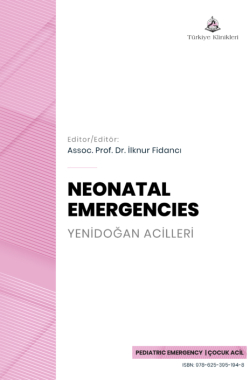Approach to Respiratory Distress of the Neonatal in the Pediatric Emergency Department
Meliha SEVİMa , Medine Ayşin TAŞARb
aUniversity of Health Sciences Ankara Education and Research Hospital, Department of Pediatrics, Ankara, Türkiye
bUniversity of Health Sciences Ankara Education and Research Hospital, Department of Pediatric Emergency, Ankara, Türkiye
Sevim M, Taşar MA. Approach to respiratory distress of the neonatal in the pediatric emergency department. In: Fidancı İ, ed. Neonatal Emergencies. 1st ed. Ankara: Türkiye Klinikleri; 2024. p.15-20.
ABSTRACT
Respiratory distress is indeed a critical issue necessitating emergency and intensive care during the neonatal period. The etiology of respiratory distress plays a paramount role in determining the course and prognosis of the condition. Achieving a definitive diagnosis and initiating timely treatment are essential for the successful management of neonates with respiratory distress. While there are numerous potential causes of respiratory distress in the neonatal period, pulmonary factors are often the primary culprits. In the initial evaluation of a newborn experiencing respiratory distress, first-line investigations should encompass essential diagnostic tools such as pulse oximetry, chest X-ray, and comprehensive blood tests, blood culture, and arterial blood gas analysis. The primary goal of initial therapy when dealing with a newborn afflicted by respiratory distress is to resuscitate the infant, alleviate the burden of breathing, optimize tissue oxygenation, and prevent the onset of hypoxia, hypercapnia, and acidosis.
Keywords: Infant, newborn; infant, newborn, diseases
Kaynak Göster
Referanslar
- Edwards MO, Kotecha SJ, Kotecha S. Respiratory distress of the term newborn infant. Paediatr Respir Rev. 2013;14(1):29-36; quiz 36-7. [Crossref] [PubMed]
- Gürel S. Respiratory Distress in Newborn. Aegean J Med Sci. 2019;2(1):38-41. [Crossref]
- Türk Neonatoloji Derneği, Tanı ve Tedavi Rehberi, Term yenidoğanda solunum sıkıntısı tanı, tedavi ve korunma rehberi 2021 [Erişim tarihi:01.09.2023] Erişim Linki: [Link]
- Warren JB, Anderson JM. Newborn respiratory disorders. Pediatr Rev. 2010;31(12):487-95; quiz 496. [Crossref] [PubMed]
- Reuter S, Moser C, Baack M. Respiratory distress in the newborn. Pediatr Rev. 2014;35(10):417-28; quiz 429. [Crossref] [PubMed] [PMC]
- Respiratory tract disorders. In: Nelson Textbook of Pediatrics. In: Kliegman R, St Gene JW, Blum NJ, Tasker RC, Shah SS, Wilson KM, eds. 21st ed. Philadelphia, PA. Elsevier; 2020. p.929-49.
- Sai Sunil Kishore M, Siva Sankara Murty YV, Tarakeswara Rao P, Madhusudhan K, Pundareekaksha V, Pathrudu GB. Approach to Respiratory Distress in the Newborn. Int J Health Research in Modern Integrated Med Sci. 2015;2(1):24-35.
- Çelik HT, Yiğit Ş. Solunum sıkıntılı term yenidoğana yaklaşım. Karaböcüoğlu M, Yılmaz HL, Duman M, editörler. Çocuk Acil Tıp Kapsamlı ve Kolay Yaklaşım. 1. Baskı. İstanbul Medikal Sağlık ve Yayıncılık Hiz. Tic. Ltd. Şti.; 2012. p.1443-51.
- Bilgen H, Yurdakul Z. Solunum sıkıntısı olan yenidoğana yaklaşım. Akalın F, Bilgen H editörler. Acil Hastaya Yaklaşım Pediatri, Marmara Üniversitesi Tıp Fakültesi Klinik Uygulamalar Klavuzu. p.110-4. [Link]
- Akalın F. Siyanoz ve hipoksik spell, Akalın F, Bilgen H, editörler. Acil hastaya yaklaşım Pediatri, Marmara Üniversitesi Tıp Fakültesi Klinik Uygulamalar Klavuzu; p.36-9. [Link]
- Aly H. Respiratory disorders in the newborn: identification and diagnosis. Pediatr Rev. 2004;25(6):201-8. [Crossref] [PubMed]
- Koç E, Kenar A. Bölüm 9 Yenidoğanda solunum sıkıntısı ve siyanoz. Akelma Z, editör. Dr. Sami Ulus Pediatri. 1. Baskı. Ankara Nobel Tıp Kitabevi; 2021. p.273-7.
- Yalaz M, Kültürsay N. Akut respiratuvar hastalıklara acil yaklaşım. Türkiye Klinikleri J Surg Med Sci. 2007;3(33):33-44.
- Mathai SS, Raju CU, Kanitkar CM. Management of Respiratory Distress in the Newborn. MJAFI. 2007;63:269-72. [Crossref] [PubMed]

